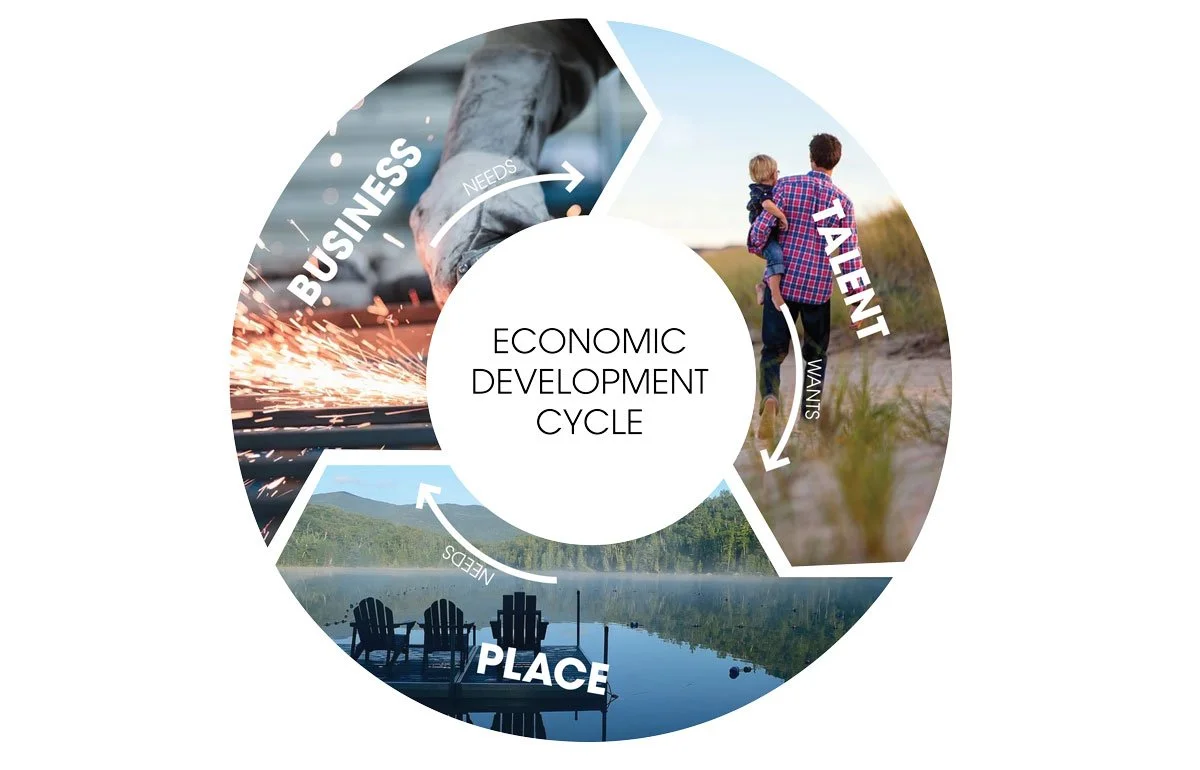Investing in What Talent Wants
Economic development experts know that thriving economies require three elements: business (which needs talent), talent (which wants place), and place (which needs business). Together, you get the economic development cycle.
In 2020 and 2021, the unprecedented rise of remote work revealed an opportunity for rural communities to attract both talent and business. A 2021 survey by PWC showed that 83 percent of employers considered the shift to remote work to be successful and 87 percent of business executives anticipate changing their real estate strategy over the next year. For towns throughout rural New York, this data should trigger investments in community placemaking amenities and infrastructure to improve place, ultimately pushing economic development.
87 percent of business executives anticipate changing their real estate strategy over the next year.
“Investment,” here means allocating funds toward the things in your community that will go on to create more money—places, spaces, and assets that attract new residents.
Imagine for a moment that you have been elected the supervisor of a rural community. You know that a resilient and growing economy needs robust infrastructure, a good supply of trained workers, and plenty of businesses. The first variable, infrastructure, is something that you can have a positive impact on relatively easily, given the right amount of funding from a variety of sources. The next variable, attracting the skilled workers that businesses will follow, is possible through placemaking.
Placemaking is the means in which communities become the place where talent and businesses want to settle. Beyond the more obvious elements that support a town or city (i.e., roads, clean drinking water, sewer systems, and even broadband), it is the non-traditional assets that improve quality of life and truly set a community apart. Examples of these soft amenities are parks, trails, marinas, music venues, museums, and libraries with dedicated meeting spaces.
One of the key questions following the American Rescue Plan Act (ARPA) federal stimulus effort is whether communities should merely spend the money they receive...or invest it. C2AE believes a primary source of placemaking investments can be ARPA stimulus funding. The U.S. Treasury has released guidance on how funding could apply to placemaking assets, which can be summarized in three points:
The ARPA is designed to respond to the needs of disproportionately impacted communities by promoting healthier living environments and outdoor recreation and socialization, which can occur within these spaces.
Communities can use stimulus funds to assist small businesses in enhancing outdoor spaces (e.g. restaurant patios) to mitigate the spread of COVID-19 or to improve the built environment.
Many communities saw a spike in park, trail, and other recreational area use during the pandemic, resulting in damage or increased maintenance needs, which makes them eligible for funding.
The State of New York, with its rolling hills, vast greenery, and waterways, is one of the most naturally beautiful regions in the nation, meaning rural New York towns have tremendous, unprecedented potential to attract talent. The BBC reports that the recent exodus of workers from cities has spawned “Zoom towns,” or “regional communities near natural amenities, where remote workers can take advantage of a higher quality of life, with more disposable income than in traditional business hubs.” What would happen if a remote worker, newly untethered from an office in the city, decided to relocate to a small town in search of better access to parks and scenic trails? Perhaps this remote worker moves with a spouse or partner, who then opens a café. The café brings new visitors into the area, and these visitors shop around town. The town brings in more tax revenue because of the new talent and business. That is the economic development cycle in action.
Rural New York towns have tremendous, unprecedented potential to attract talent.
This snowball effect is, of course, contingent upon that town having sufficient traditional assets—critical roads, sewers, drinking water systems, and broadband—to support more residents. Some small towns near outdoor recreational areas out west have experienced “rural gentrification,” wherein longtime residents are displaced by high-earning remote workers due to a lack of adequate infrastructure to account for the rising population. As a funding advisor here at C2AE, I suggest that rural communities finance their traditional infrastructure improvements or expansions with established state and federal sources that will continue to be available long after ARPA funds are gone. These sources include the Drinking Water State Revolving Fund (DWRF) and the Clean Water State Revolving Fund (CWSRF) among many more options. The great news for towns is that traditional and non-traditional infrastructure improvements can occur concurrently using these different funding sources.
Finally, as a result of these different projects, that town we talked about has the right infrastructure, space, and talent to attract large businesses (think durable goods, automotive, and food processing manufacturers). Such companies can create hundreds or even thousands of high-wage jobs in a single region. Some businesses are already looking to relocate to the Northeast and Midwest regions as climate change continues to create natural disasters in coastal areas. The communities with robust infrastructure and large talent pools will be the most appealing to new businesses.
To reinforce this point, let's look to the past. When the United States started to show signs of recovery from the Great Recession, many manufacturers began exploring options for expansion or relocation. In response to the recovering economy, IndustryWeek released a list of considerations for plant site selection; among those considerations were both labor needs and quality of life. Simply put, businesses follow people, and people want to live in good places. So if your town is hoping to capitalize on ARPA funds to create economic resilience and growth, the clear answer is to invest in placemaking.

